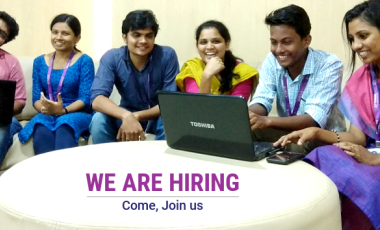Walk the Talk - An interview with Vimal Joseph
Vimal Joseph, Technical Architect, Zyxware Technologies is an ardent proponent of the free software philosophy. His arrival was marked by quite a few changes in Zyxware. The version control system ‘git’, our project tracker, etc are a very few of the changes he put forward in Zyxware. He is a man of integrity and discipline as one can see from the Zyx3 office that he heads. We Zyxians often joke that Zyx3 is the quietest when he is present! He is by nature a quiet, calm horse and he thinks he is an introvert. He has provided technical consultancy for various external agencies like Kerala State IT Mission, State Institute of Encyclopedic Publications, University of Calicut on projects like Malayalam Computing, ICT for Visually challenged people (Insight), Migrating content to Media wiki etc…
This is a sneak peek into the mind of our dear Vimal Joseph, the tech genius.
Zyxware is now 9 years old. You have been in zyxware for almost 5 years. Could you please run us through your time at zyxware and how you saw the organization evolve?
“I joined Zyxware to start the Ernakulam operations, as an expansion of Zyxware. I was the first experienced person to join Zyx3 (Ernakulam Office). I was recruited directly by Anoop, as he is a friend of mine. I knew him from the previous organization I had worked for. After I joined zyxware, we did a set of interviews and recruited the initial staff for Zyx3 (Kochi) office and in a span of around 2 or 3 months, we recruited 5 more people. We regularly conducted the recruitment process, acquiring more employees to Zyxware. At present, in our software development section we have 54 members, and are able to handle significantly large projects. When I look back over the past 5 years, we have achieved a lot, though the growth of Zyxware, so far, was organic. Now we have a strategy group and they are working on a concrete growth plan for Zyxware, which is aligned to our vision and mission. We started our operations in Australia, and have now started an office at technopark and a mobility division at Kochi. The growth of Zyxware is now prominent!”
You said you knew Anoop from the previous organization you had worked for. Which was the previous organization? How was it like?
“The previous organization I worked for was SPACE. SPACE is a “Society for Promotion of Alternative Computing and Employment” where free software is a way of life. I joined space as our visions were aligned. I'm lucky enough to have worked in a field that I love.”
When and how, did you recognize you interest in Free Software?
“In Order to answer that question I will have to say why I'm interested in programming…”
“My first exposure to the technological marvel of computers was way back in the late 90's, which was during my college days. The lab was where the computers were located and it was all DOS based systems. Back then we used a networking system named Novell Netware. Our first programming language was Pascal. As you all know 'Hello world' is usually the first example for any programming language and my first program was to print “Hello World” and such strings. But surprisingly, my instructor asked me to write a program! A program which changed my perspective. The problem was to reverse a number. The problem seems simple, but there were few rules. 1) We should not use simple string reverse functions or store the characters in an array and print array in reverse order. 2) It should handle numbers with any base, even hexadecimals. I understood that in order to solve this problem, I needed an understanding of how this number was generated. We need to structurally split the problem. Humans can easily reverse a number. If it is 123, humans will easily say the reverse of it is 321, but we cannot explain that to a person who has no idea what a number means. So, in order to solve this problem, we need to go deeper. We should understand how a number is formed, what is the base of that number and so on. Then, we should also think of how to reverse a number irrespective of its base. If we unlock how it is created, we can generalise it and find the solution to the problem. This thought struck me; By thinking in a structured way, I can make the computer do anything. We are here because we get an enjoyment out of construction. When we were kids, we used building blocks to create different structures and we were always happy when we look at something that was created by ourselves. It is the same happiness I feel, when I see a software I created and that is how I became interested in programming.”
So, about your interest in Free Software..
“I'm coming to that. During my college years, I created a number of simple softwares, and then, I ran out of ideas! 'What to create next?' was my question to myself. The idea that came to me then, was to duplicate an already existing software. At the time, the editor I used was Turbo Pascal. There was a text viewer along with it. So, I thought about how such a text viewer was implemented in a command line application and that thought led me into creating a similar text viewer, In which the up/down arrow keys worked as a scroller. PC Quest and Chip where the popular tech magazines back then and I used to enjoy reading them. The magazines came along with a CD and one of those CDs had the most popular snake game; The one we used to play in our old mobile phones. I was able to duplicate that game too and I shared the source code with my friends. Along with the PC quest magazine I got the GNU/Linux CD which was a distribution of PCQ Linux. I installed it in my computer but could not get the graphical interface running, instead, I got only a command prompt. Prior to this, I had seen in the paper that Richard Stallman had come to Kochi, which was in 2001. I came to know that Stallman was famous for creating a software named Emacs. So, in the command prompt of my computer, in which I had just installed GNU/Linux, I simply typed in ‘emacs’. A blank screen popped up, and so, I wanted to know more about Emacs. There was a help link in Emacs, where there was an article about the GNU project. This article drew my attention to software freedom. Because in that article Richard Stallman had beautifully narrated the need of Free Software, and his vision behind it and I could relate to that. As I had mentioned before I had a lot of trouble duplicating other softwares as their source code were not open. If the source code were available it would be easy for people to learn it. In 1983, all operating systems for modern computers had become proprietary software. So, this meant that it was impossible to buy a new computer and use it freely, hence Stallman an operating system developer, started a project to create an operating system (GNU - GNU is Not Unix) which is free. Free in the sense the users have the freedom to run, copy, distribute, study, change and improve the software. I was very much inspired by him and was attracted to his philosophy.”
How did you reach SPACE?
“When I got interested in free software, I communicated with people who share the same philosophy. When Richard stallman again came to india, in the year 2002, I was excited and decided to go and hear him out on Free Software.. There I met Arun M, Secretary of Free software foundation of India (FSFI) and acquainted him and we talked a lot about free software. That time, schools had started teaching computer to 8th graders. The teacher training was organised using help from the Intel Teach to the Future programme, and their course material, which was wholly based on Microsoft software, was used for the training.The textbook for IT was based purely on Microsoft Windows and other Microsoft applications like MS Of?ce. The Free Software community in the state found this very offensive, since it ignored the existence of Free Software and promoted the products of one company. Under the leadership of Arun M a campaign started, which was initialized by FSF India and I even I took part in that campaign. Sajith, who was a member of FSFI, along with Arun M, created a distribution named EduMorphix by customizing Morphix, a Debian based live CD and added education related applications to it. Sajith gave me a copy of the cd, I checked it and suggested some modifications and we released another version of it. In the year 2005, SPACE was planning to set up an office and formally start its activities with an international conference on free software. That time Arun invited me to join SPACE and I happily agreed. The main aim of SPACE was to spread free software awareness, and to create a mechanism to support it.”
How was the transition from SPACE to Zyxware?
“During the Freedom Walk of Zyxware, SPACE had helped the Freedom walk team in conducting campaigns across Kerala where SPACE and FSF India had contacts. That is how I came to know more about Zyxware and that is how me and Anoop became friends. In 2010 I had to shift to Ernakulam and Anoop had an idea of expanding Zyxware, he wished to start a development unit at Kochi apart from the one at Trivandrum. Anoop discussed this with me and, here I am! Zyxware was totally different from SPACE. I hadn't done any web applications before and I barely knew php. I learned all these by teaching. In my experience, not knowing a specific language is not at all a problem for a strong programmer. I love teaching and in Zyxware I get a lot of opportunity for teaching. Even now when Anoop says we have to learn a particular thing, I would say 'ok we’ll take a lecture series on that'...”
You are passionate about coding. But being in a Technical Architect role, you seldom write code. How do you feel about it?
“Coding involves creating a set of instructions, rules or a description in a formal language, which the computer can interpret, to achieve a particular objective. Software Designing on the other hand involves computation. That involves some creative thinking. I get more satisfaction while designing software or while creating algorithms for a problem than writing codes. Debugging also gives me some kind of a thrill. In a tech architect role, I get to design softwares and to debug a situation which gives me more satisfaction and happiness.”
How do you feel working at the same office as or alongside your spouse?
“We always know what one another is going through professionally hence we understand each other better. The only flip side which I can find is that, I have a behavior (a bad one, of course) of sitting late at the office to complete something, it seems that Emily learned from me and she also tend to sit late now.”
Are you having a happy association with zyxware? What do you think Zyxware will look like in the future, say five years from now?
Of Course I'm having a happy association with zyxware and I think everyone in Zyxware will have a bright future. We are one of the few companies which are not solely investment-driven. As for 2019, with a collective effort from all of us there is nothing stopping us from taking the lead in software industry. By then we will be over a 1000 employees with every one of us playing a very different role than we are having now.
An inspiring man, Vimal Joseph, it is no doubt that he would take Zyxware to it’s heights and all of us along with him, as is his vision. He is passionate about programming, free software, teaching and us Zyxians should be proud to have him as our Technical Architect. An excellent teacher, as most of us know first hand, he is the one who trains almost all new employees and mould them to be compassionate programmers.



